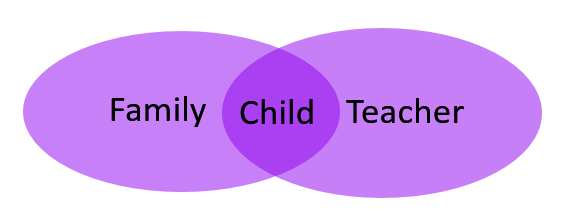Previous chapters have introduced reflection as a process we engage in to better ourselves, our practices, and by extension our programs. Working with families will bring an additional piece to our reflection as we continue to understand our values and beliefs and how they affect the way, we view different families. Are we feel more comfortable with some family structures over other family structures? Do we agree with certain family discipline techniques and not others? Do we connect with some families more than others?
These are all natural; after all, we all come from a family that has instilled certain beliefs and mindsets in us. Having these feelings is expected; acting upon them as an early childhood professional is different. All family members deserve respect and to feel valued. Just because they do something differently does not necessarily make it “wrong”. We do not know what happens in a full day with that family any more than they know what happens in yours. We get a glimpse into the small portion they want to share with us, which may or may not be indicative of the rest of the picture. If we approach our families with a reflective lens, we can do much to understand and truly collaborate with them.
To begin this process, it is helpful to consider the following questions:
- How can I learn more about that family?
- What kinds of opportunities can I provide for families to be a part of their child’s classroom experience?
- How can I help all families feel connected, respected, and valued?
- What judgments/assumptions do I have about different family structures? How do those judgments/assumptions get in the way of me connecting with all of my families?
|

|
Pause to Reflect
Which of these questions resonate with you? Are there others you might add?
|
Previous chapters have also repeatedly emphasized the importance of establishing relationships; providing a warm, safe, and trusting environment; and creating long-term connections with the children we work with. By extension, we can employ those same measures for each family member. A family is entrusting you with a very large and special portion of their life, often with very little knowledge of who you are. Finding ways to help them feel secure in their decision will go along way towards bridging the two most important worlds of a child’s existence.
|

|
Pause to Reflect
What strategies that you have already considered using to make children feel comfortable and valued might you use with their families?
|
To serve families holistically, it requires a shift in our thinking. It is common for teachers to feel as if they are the experts, and that parents bring their children to us for our expertise. While this may be partially true, we need to understand that although we may be the experts in the way children develop and learn in general, parents are equal experts in their particular child. This acceptance of two complementary but different types of knowledge allows us to form true partnerships with families. It allows all parties to be better than they would on their own. How exciting it is, to learn from families all that they have to offer! How wonderful for a child to know that everyone is behind them, supporting them in the ways that they know best.

Figure \(\PageIndex{1}\): The relationship between family and teacher centers on the child




